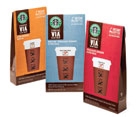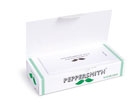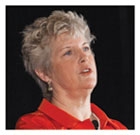
Method co-founder Eric Ryan kicked off day one with an inspiring talk.
After the last couple of years, marketers and designers have been feeling a deep need for a brand refresh-a new start. And they got just the spark they needed with the idea of “relevance” that emerged as the thread connecting nearly every speaker at our Packaging that Sells conference in September.
“It’s no longer enough for people to believe that your product does what it says. They want to believe in you and what you do,” said Method co-founder and brand architect Eric Ryan in a keynote to the more than 300 packaged goods marketers and designers in attendance.
In his engaging style, Ryan explained the ways Method has taken on multi-billion cleaning giants like P&G and Unilever. “We compete on the product experience, of which packaging is the core,” he said.
That led to a manifesto of sorts, with Ryan calling on packaged goods companies to put creatives in charge of the brand and to follow Method’s lead in elevating design to a leadership level. “The soul cannot be outsourced,” he explained.

Starbucks
offered insights into its $100 million Via brand.
Up next was Starbucks’ vice president of strategic coffee initiatives Aimee Johnson, who shared the story of Starbuck’s Via Ready Brew instant coffee (which earned the company $100 million within 10 months of its launch). Johnson’s main thrust was that innovation is a balance between intuition and fact. Disciplined problem solving and consumer insights can help navigate risk, she said, but intuition and “gut feelings” should remain part of the process.
Johnson shared early brand identity and package design directions (a rare treat), and offered great advice for fellow marketers and designers on how to gain support from senior leadership. “Approach your executive committee as if they were venture capitalists,” she said.
The conference then turned to the creative team from Target, which explained how an audit of the retailer’s store brand portfolio identified a big opportunity to rebrand its “commodity” label and make it a destination brand.
Starting with ethnography and competitive research, the team came up with a mind-boggling 1500 names before deciding on Up & Up, which, they felt, communicated a positioning of “everyday optimism”. They shared early design directions with us, including an interesting (but perhaps too progressive) concept that used pixilated photos as the main imagery.
The final solution came with a predominantly white packaging system that pops on the shelf and uses color to differentiate varieties across 15 categories and 900 SKUs (with what sounds like more to come!). Next up was what attendees described as a “daring” and “gutsy” presentation by Kimberly Clark brand design director Jennifer Westemeyer, who opened her talk on the new U by Kotex brand by asking, “Who wants to talk about vaginas today?”
It was an attention-grabbing start but it brought home the core of U by Kotex’s effort to break the stigma associated with feminine hygiene. Making a paradigm shift from “period management” to “personal care,” the brand took design inspiration from the fashion and cosmetics categories and went with the bold choice of black packaging, which incorporated thoughtful details like a die-cut window that actually showcases the products.
“Cut the crap, be honest with your consumers,” said Westemeyer. Good advice for any brand-and more credible when it comes from one that’s now credited for a truly successful category reinvention.
From there, Glidden continued the refresh theme, with Renee Entinghe offering what could have been a disheartening backstory: a five-year decline, 40 percent market share loss and an allocation of only eight feet of retail space (compared to 16 feet enjoyed by its closest competitor).
The solution came in optimizing what space the brand did have. Sporting a design with “badge value,” the packaging picked up nearly a point in market share, big volume increases and increased Glidden household penetration-but Entinghe said that its biggest achievement was winning the business of Walmart.

Peppersmith talked of a vision to become the UK’s best-loved
gum brand.
Shrimpton explained how he’s working to make gum more relevant to adults by avoiding the “plastic-y,” “kid-like” attributes of the category and, instead, taking the brand into the natural, healthy world of today’s food and drink.
Packaging, of course, serves as a primary driver. The gum is housed in a white paperboard box with details like embossing, spot varnishes and, most unexpectedly, a top flap that contains wrappers so consumers can responsibly discard their gum after use. The goal, he said, was to develop a gum pack that would have the import of an iPhone or Zippo lighter, where consumers would set it out in front of them on the tabletop in a bar.

Claudia Kotchka energized day two with a motivating presentation.
Perhaps most interesting were the not-so-subtle nudges Kotchka gave brand leaders. For one, avoid the design brief that asks for everything: It must be breakthrough but it must cost less. That’s simply wrong thinking, she said. “If you want ‘breakthrough,’ you’ve got to invest in it.”
She also echoed Eric Ryan’s sentiment for companies to elevate design to executive status. But, barring that, she said, you need to be the best client for your design partners. Rather than treat them like suppliers, she said, bring them into your business problem. “Don’t tell [them] to build you a bridge. Show [them] the canyon.”
Following Claudia’s talk was an interesting look at a rarely considered side of sustainability: the complex recycling chain. Dietmar Offenhuber of MIT’s SENSEable City Lab explained how the group’s TrashTrack project is using smart tags to monitor consumer waste. Uncovering the statistic that 70 percent of the waste from Seattle is exported to Asia, Offenhuber’s work naturally creates new questions: Do those transport distances diminish the impact of recycling? Or, the benefit of using recycled material in our packaging? Lots of food for thought, to be sure.
Closing out the conference was Katrina Markoff, founder of Vosges Haut Chocolat, who is taking on global chocolate giants by infusing her products with inventive flavors and turning them out in boldly designed, layered packaging. Admittedly, the highlight of her talk was the guided tasting (my favorite: the Indian curry/coconut bar. Nom, nom, nom!). The ingenious flavor mix was just the right note to end the inspiring talks at Packaging that Sells. The mix of challenger brands and consumer goods giants showing off their creative and strategic prowess-and the insights, inspiration and connection-making opportunities we enjoyed over the day and a half-left all of us thoroughly refreshed.
Editor’s Note:
Visitwww.packagingthatsells.comor follow www.twitter.com/packagingsells for 2011 Packaging That Sells dates.
To see more photos from the conference, check outwww.facebook.com/BrandPackaging.
